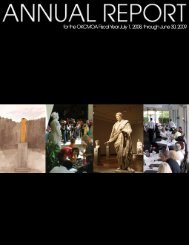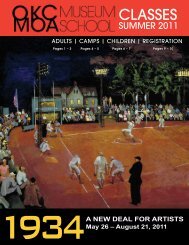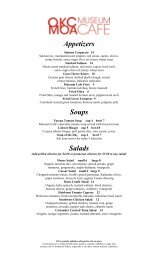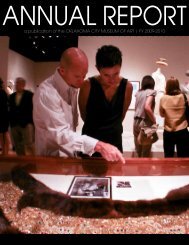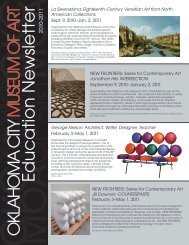Roman Art from the Louvre Educators' Resource Guide
Roman Art from the Louvre Educators' Resource Guide
Roman Art from the Louvre Educators' Resource Guide
You also want an ePaper? Increase the reach of your titles
YUMPU automatically turns print PDFs into web optimized ePapers that Google loves.
22<br />
Discussion Starters<br />
1. Describe <strong>the</strong> scene represented in this<br />
mosaic. What is represented in <strong>the</strong><br />
border?<br />
2. Do you think a scene <strong>from</strong> <strong>the</strong> Judgment<br />
of Paris is appropriate for a dining room?<br />
Why?<br />
3. Why do you think <strong>the</strong> <strong>Roman</strong> artist<br />
created a composition that was borrowed<br />
<strong>from</strong> a Greek wall painting?<br />
4. What do you think might be some of <strong>the</strong><br />
challenges of creating a mosaic? What are<br />
some of <strong>the</strong> benefits of working this way?<br />
5. Is <strong>the</strong> scene on <strong>the</strong> mosaic realistic? Is<br />
<strong>the</strong>re a lot of natural detail? How has <strong>the</strong><br />
artist used color, line, and shadow to<br />
convey three-dimensional space?<br />
6. Why do you think <strong>the</strong> homeowner chose<br />
to decorate his dining room floor with a<br />
mosaic? What does this type of home<br />
decoration tell you about <strong>the</strong> owner of <strong>the</strong><br />
house?<br />
7. What kinds of decoration do you have in<br />
your home? Do you have any ceramic tiles<br />
or mosaics? How do you think home<br />
decoration today is different <strong>from</strong> that in<br />
ancient <strong>Roman</strong> times? How is it similar?<br />
Activity: Making a Mosaic<br />
Materials: graph paper, colored paper,<br />
poster board, glue (optional: use small<br />
colored ceramic tiles instead of colored<br />
paper)<br />
Procedure:<br />
1. Ask students to design a mosaic to<br />
decorate a floor. Provide <strong>the</strong>m with graph<br />
paper to make a drawing of <strong>the</strong>ir mosaic<br />
design. Students can create a pattern or a<br />
picture.<br />
2. Give each student a stack of colored<br />
paper. Ask <strong>the</strong>m to cut <strong>the</strong> paper into<br />
half-inch squares. Put <strong>the</strong> squares in a box<br />
and mix <strong>the</strong>m up.<br />
3. Give each student a large handful of <strong>the</strong><br />
colored squares, a piece of poster board,<br />
and glue.<br />
4. Ask students to create a mosaic of <strong>the</strong><br />
design <strong>the</strong>y sketched earlier.<br />
2. Mosaic Panel<br />
2nd half of <strong>the</strong> 1st–early years of 2nd century A.D.<br />
Discovered at Daphne, near Antioch on <strong>the</strong> Orontes (Turkey),<br />
House of <strong>the</strong> Atrium, 1932<br />
Marble, limestone, molten glass<br />
73G x 73G in.<br />
Musée du <strong>Louvre</strong>; Transferred 1936, excavation of 1932 under <strong>the</strong><br />
direction of Princeton University, with <strong>the</strong> support of <strong>the</strong> National<br />
Museums of France, <strong>the</strong> Baltimore Museum of <strong>Art</strong>, and <strong>the</strong> Worcester<br />
<strong>Art</strong> Museum (MA 3443–inv. mnd 1945)<br />
Mosaic is <strong>the</strong> art of arranging tiny pieces of glass, stone, or o<strong>the</strong>r materials—called<br />
tesserae—to create a pattern or a picture. The mosaic panel<br />
shown here boasts a rich palette of colors and remarkable effects of light,<br />
shadow, and depth.<br />
This composition was based on a Greek wall painting that depicts <strong>the</strong> god<br />
Hermes as he entrusts <strong>the</strong> Trojan prince Paris with <strong>the</strong> task of selecting <strong>the</strong><br />
most beautiful goddess <strong>from</strong> among A<strong>the</strong>na, Hera, and Aphrodite—a scene<br />
<strong>from</strong> Greek mythology known as <strong>the</strong> Judgment of Paris. A popular <strong>the</strong>me<br />
in antiquity, <strong>the</strong> Judgment of Paris was often understood as a struggle<br />
between pleasure and virtue.<br />
In <strong>the</strong> mosaic, Hermes, messenger of <strong>the</strong> gods, is shown on <strong>the</strong> left, speaking<br />
to Paris, who holds one of <strong>the</strong> sheep he was tending as a shepherd. The<br />
three goddesses wait nearby. A<strong>the</strong>na, <strong>the</strong> goddess of wisdom, is on <strong>the</strong> left<br />
with her helmet, shield, and lance; while Hera, <strong>the</strong> queen of <strong>the</strong> gods, sits<br />
majestically in <strong>the</strong> center, carrying a long scepter. Aphrodite, <strong>the</strong> goddess<br />
of love, is also equipped with a scepter and leans casually against a rock,<br />
convinced of her success. Paris’s choice of Aphrodite sets in motion a series<br />
of events that ultimately result in <strong>the</strong> Trojan War, but <strong>the</strong>re is no indication<br />
of those consequences here.<br />
This mosaic was <strong>the</strong> centerpiece in <strong>the</strong> dining room (triclinium) of an elaborate<br />
house in <strong>the</strong> eastern <strong>Roman</strong> capital of Antioch, in present-day Turkey.<br />
The triclinium was a reception room in which guests dined while reclining<br />
on a U-shaped arrangement of couches. Several o<strong>the</strong>r mosaic panels were<br />
featured in <strong>the</strong> room’s decoration, including figures of <strong>the</strong> wine god Bacchus<br />
and Hercules engaged in a drinking contest, a satyr and a maenad (a<br />
mythic follower of Bacchus), and Aphrodite and her love interest, Adonis. A<br />
border of grapes and ivy leaves filled with insects, lizards, and birds frames<br />
<strong>the</strong> scene.




